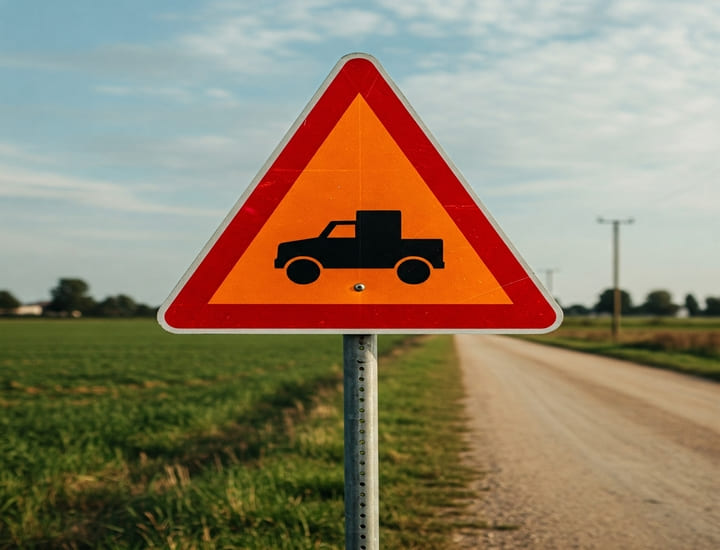When we’re driving down a country road or a busy highway, we might have noticed a bright, reflective orange triangle on the back of certain vehicles. This is no ordinary sign—it’s called a slow moving vehicle sign, and it plays a vital role in keeping our roads safe. In this article, we’ll dive into what the slow moving vehicle sign is, why it’s so important, and how it helps prevent accidents. By the end, we’ll have a clear understanding of why this simple triangle is a lifesaver on the road.
What Exactly is a Slow-Moving Vehicle Sign?
The slow moving vehicle sign is a bright orange triangle with a red border. It’s designed to be highly visible, even from a distance. This sign is placed on vehicles that move at a speed of 25 miles per hour (40 kilometers per hour) or less. These vehicles are often too slow to keep up with regular traffic, so the slow moving vehicle sign acts as a warning to other drivers.
Where Do We See Slow Moving Vehicle Signs?
We’ll typically find slow moving vehicle signs on vehicles like:
- Tractors used in farming
- Construction equipment like bulldozers and road rollers
- Horse-drawn carriages in rural areas
- Road maintenance vehicles such as street sweepers
Why is the Slow Moving Vehicle Sign So Important?
The slow moving vehicle sign isn’t just a piece of reflective material—it’s a critical safety tool. Here’s why it matters:
1. It Warns Other Drivers
The bright orange color and reflective surface of the slow moving vehicle sign make it stand out, even in low-light conditions. This helps drivers behind the slow-moving vehicle notice it from a distance and adjust their speed accordingly. Without this sign, faster-moving vehicles might not realize how slow the vehicle ahead is until it’s too late.
2. It Prevents Accidents
Slow-moving vehicles can be a hazard on roads where most drivers are traveling at higher speeds. The slow moving vehicle sign reduces the risk of rear-end collisions by giving drivers enough time to slow down or change lanes safely. It’s a small sign that can prevent big accidents.
3. It Protects Farmers and Workers
Many slow-moving vehicles are used in agriculture or construction. These workers often operate in areas where traffic is fast-moving. The slow moving vehicle sign helps protect them by making their vehicles more visible to others on the road.
4. It’s Required by Law
In many places, using a slow moving vehicle sign on slow-moving vehicles isn’t just a good idea—it’s the law. This ensures that all drivers follow the same safety standards and reduces confusion on the road.
How Does the Slow Moving Vehicle Sign Work?
The slow moving vehicle sign is a simple yet effective tool. Here’s how it works:
1. High Visibility
The sign is made of reflective material, which makes it easy to see during the day and at night. When headlights hit the sign, it reflects the light, making it even more noticeable.
2. Proper Placement
The slow moving vehicle sign is always placed at the back of the vehicle, usually at eye level for other drivers. This ensures that it’s clearly visible to anyone approaching from behind.
3. Speed Indicator
The slow moving vehicle sign is only used on vehicles that travel at 25 mph (40 km/h) or less. This helps other drivers understand that the vehicle ahead is moving much slower than the flow of traffic.
Challenges with Slow Moving Vehicle Signs
While the slow moving vehicle sign is a great safety tool, it’s not without its challenges:
1. Misuse of the Sign
Sometimes, the slow moving vehicle sign is used on vehicles that don’t meet the speed requirement. This can confuse other drivers and reduce the effectiveness of the sign.
2. Wear and Tear
Over time, the reflective material on the slow moving vehicle sign can wear out, making it less visible. Regular maintenance and replacement are necessary to keep the sign effective.
3. Lack of Awareness
Not all drivers understand what the slow moving vehicle sign means. This can lead to dangerous situations if drivers don’t slow down or give enough space to the slow-moving vehicle.
How to Overcome These Challenges
1. Use the Sign Correctly
Only vehicles that travel at 25 mph (40 km/h) or less should use the slow moving vehicle sign. This ensures that the sign is used correctly and maintains its purpose.
2. Regular Maintenance
We should check the slow moving vehicle sign regularly to ensure it’s clean and in good condition. Replacing the sign if the reflective material is worn out or damaged is essential.
3. Educate Drivers
Public awareness campaigns and driver education programs can help more people understand the meaning and importance of the slow moving vehicle sign. This can reduce confusion and improve road safety.
Tips for Drivers
If We See a Slow Moving Vehicle Sign
- Slow down and maintain a safe distance.
- Be patient and wait for a safe opportunity to pass.
- Avoid sudden movements or aggressive driving.
If We Drive a Slow-Moving Vehicle
- Always use the slow moving vehicle sign if our vehicle travels at 25 mph (40 km/h) or less.
- Keep the sign clean and visible.
- Drive in the right lane and avoid blocking traffic.
Conclusion
The slow moving vehicle sign is more than just a bright orange triangle—it’s a lifesaver. By warning other drivers about slow-moving vehicles, it helps prevent accidents and keeps everyone on the road safe. Whether we’re drivers or the operators of slow-moving vehicles, understanding the importance of the slow moving vehicle sign can make a big difference. Let’s work together to promote road safety and ensure that everyone reaches their destination safely.

